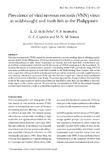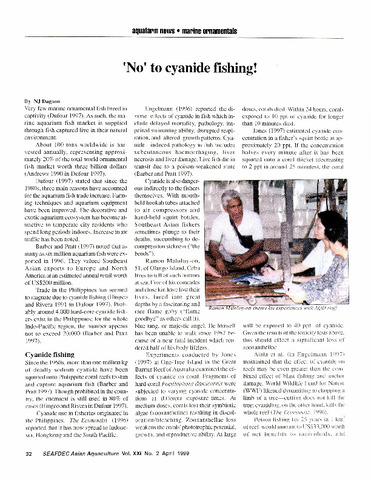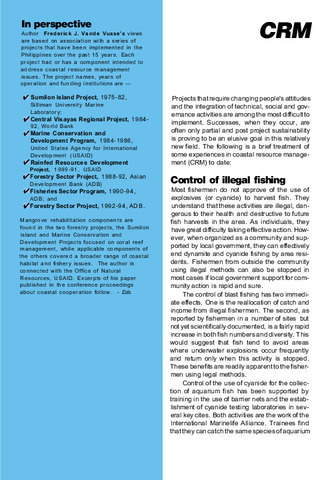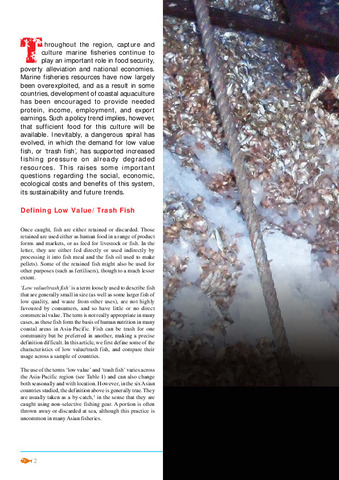Prevalence of viral nervous necrosis (VNN) virus in wild-caught and trash fish in the Philippines
Share
Abstract
Viral nervous necrosis (VNN) caused by piscine nodavirus is a devastating disease affecting mainly marine finfish. In the Philippines, VNN was first reported in hatchery-reared grouper (Epinephelus coioides) broodstock in 2001. These broodstock are usually fed with trash fish. It is therefore suspected that contaminated trash fish may be the source of VNN transmission to the broodstock. To confirm the source of contamination, periodic monitoring of the VNN prevalence using RT-PCR was done on different species of trash fish available in the Iloilo Fishing Port Complex and on the wild-caught fish in Panay Gulf. Results showed that most of the trash fish and wild-caught fish were sub-clinically infected or carriers of VNN, and that the virus might have already been established in the environment where they were living. These findings provide strong evidence that trash fish could be the main source of viral contamination in broodstock since they are identified as the only major input in the culture systems. To prevent the transmission of VNN to broodstock through contaminated trash fish, a shift to a broodstock pelleted feed is highly recommended.
Suggested Citation
de la Peña, L. D., Suarnaba, V. S., Capulos, G. C., & Santos, M. N. M. (2011). Prevalence of viral nervous necrosis (VNN) virus in wild-caught and trash fish in the Philippines. Bulletin of the European Association of Fish Pathologists , 31(4), 129-138. http://hdl.handle.net/10862/2114
Subject
marine fish  ; trash fish
; trash fish  ; fish diseases
; fish diseases  ; viroses
; viroses  ; viruses
; viruses  ; PCR
; PCR  ; disease recognition
; disease recognition  ; breeding stock
; breeding stock  ; Epinephelus coioides
; Epinephelus coioides  ; Panay Gulf
; Panay Gulf  ; Iloilo
; Iloilo  ; Tigbauan
; Tigbauan 
 ; trash fish
; trash fish  ; fish diseases
; fish diseases  ; viroses
; viroses  ; viruses
; viruses  ; PCR
; PCR  ; disease recognition
; disease recognition  ; breeding stock
; breeding stock  ; Epinephelus coioides
; Epinephelus coioides  ; Panay Gulf
; Panay Gulf  ; Iloilo
; Iloilo  ; Tigbauan
; Tigbauan 
Taxonomic term
Collections
- AQD Journal Articles [1215]
Except where otherwise noted, this item's license is described as http://creativecommons.org/licenses/by/2.5/scotland/
Related items
Showing items related by title, author, creator and subject.
-
'No' to cyanide fishing!
Dagoon, N. J. (Aquaculture Department, Southeast Asian Fisheries Development Center, 1999) -
CRM in the Philippines: Lessons learned
Southeast Asian Fisheries Development Center, Aquaculture Department (Aquaculture Department, Southeast Asian Fisheries Development Center, 1996)Philippine coastal communities can become capable fishery resource managers and that their management practices can become largely self-sustaining if the project approach focuses on assisting fishermen to learn how to help ... -
Prized commodity: Low value/trash fish from marine fisheries in the Asia-pacific region
Staples, Derek; Funge-Smith, Simon (Secretariat, Southeast Asian Fisheries Development Center, 2005)The use of the terms 'low value' and 'trash fish' varies across the Asia-Pacific region and can also change both seasonally and with location. This article defines low value/trash fish as 'Fish that have a low commercial ...






